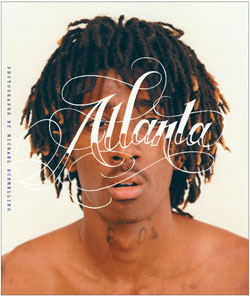PHOTOGRAPHER MICHAEL SCHMELLING’S NEW BOOK, CAPTURES THE CITY’S VIBRANT HIP-HOP CULTURE
PUBLISHED BY CHRONICLE BOOKS ON NOVEMBER 1st,
THE VOLUME INCLUDES ESSAYS BY KELEFA SANNEH AND
WILL WELCH’S INTERVIEWS WITH ANDRÉ 3000, BIG BOI, GUCCI MANE, LUDACRIS, SHAWTY LO, AND THE-DREAM
ACCOMPANYING DOWNLOAD FEATURES UNRELEASED TRACKS FROM THE SCENE’S RISING STARS

Chronicle Books will publish Atlanta, the new book from acclaimed photographer/director/author Michael Schmelling, on November 1st. Atlanta evokes the incredible diversity of the city’s hip-hop scene, capturing the lives of everyone from up-and-coming rappers to club kids to multi-Platinum artists. It also includes a series of insightful essays by The New Yorker‘s Kelefa Sanneh. Exclusive interviews with key figures like André 3000, Big Boi, Gucci Mane, Ludacris, Shawty Lo, and The-Dream were conducted by Will Welch, an associate editor at GQ.
Each book will contain a code enabling readers to download a mixtape of tracks from many of the unsigned musicians featured in Atlanta, including Travis Porter, 3rd Degree, Pill, Lil Texas (who is the subject of the striking cover image) and Them Concrete Boyz.
“We wanted to let people hear the music that the kids in the book are making in their homes and self releasing,” says Schmelling, who was the principal photographer for The Wilco Book. His work has appeared in numerous magazines and newspapers and has been exhibited throughout the U.S. and Europe.
Between 2007 and 2009, Schmelling and his collaborators gained unprecedented access to the underground hip-hop scenes bubbling beneath the city’s surface and the lives of the young musicians and fans at its core. In a stunning series of black and white photos, he captures the heretofore-undocumented teen party scene – alcohol-free parties catering to the underage crowd, typically thrown by promoters in office parks after dark.
Like Atlanta’s ever-evolving music scene, Schmelling’s concept for the book changed over time. He initially envisioned a photo book based on OutKast’s Aquemini. But as he immersed himself in the culture, he decided instead to look back by looking forward.
“So we found kids who were the same age as André and Big Boi were when they were first making records,” Schmelling recalls in the book. “There were a thousand YouTube videos of kids dancing in their living rooms, beats and songs were being made on PCs and uploaded to SoundClick or SpitYoGame. Something new was happening. And something new kept happening.”
Sanneh puts things into historical perspective, describing how Atlanta replaced New York City as the hip-hop capital “by default – the place where you could hear the next hit first, the place where kids and grown folks alike still seemed excited about hip-hop, the place where you could get the best mixtapes” and taking readers inside its many subgenres.
André 3000 acknowledges the shift in a rare interview, conducted by Welch: “If you look at what was goin’ on at the time, we came out with Nas. We came out with Biggie. We came out with WuTang. As far as rhyming and being from the South? We couldn’t mess around. All of our contemporaries made us better. Nowadays, the competition for a lot of the kids in the South is just their neighborhood.”
Atlanta – and its accompanying download mixtape – takes us inside those neighborhoods, capturing a culture that’s always in transition. “The story of Atlanta hip-hop is whatever is happening right now,” says Schmelling. “A year in Atlanta hip-hop is like five years in any other genre.”
For more information about Atlanta:
Bobbie Gale
BIG HASSLE MEDIA
p: 323-456-3490
e: bobbie@bighassle.com
or visit:


Leave a Reply